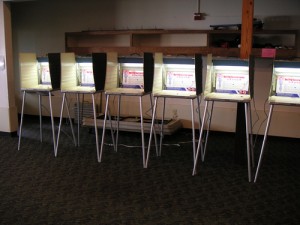Lies About Hispanic Voting Patterns
 By José de la Isla, Voxxi
By José de la Isla, Voxxi
HOUSTON — Are you worried about how many Latinos will vote in 2050? Evidently you should be, according to the National Journal. Because, well, I don’t know why.
Some Hispanic leaders worry that their political influence will ebb in November and that today’s population trends will have fallout more than 40 years from now, Ronald Brownstein writes in The National Journal’s Next America project, available online.
Some days, I get the impression these concerns are just made up. I guess this piece of political information ranks up there with the space invasion problem.
First, let’s set the parameters. For 40 years there was indifference — even disdain — regarding Hispanic voting patterns. Now the Chicken Little school of politics claims there’s a problem looming ahead over the next 40.
The authoritative “Almanac of Latino Politics 2012” from the U.S. Hispanic Leadership Institute tells the real story. This group has compiled the longterm history of Latino voter participation statistics.
At least in terms of a documented pattern, Latino voting has been of national consequence since cast their votes. Latino participation grew steadily with every subsequent presidential election. In 1996, Latinos formed part of the voting coalition that brought Bill Clinton to the White House.
By the 2004 election, Latino votes reached 7.5 million, and that total increased by 2.2 million four years later – combining with the youth and women vote to help Barack Obama win the presidency.
Yet, in the previous 40 years, political commentators had mostly expressed disbelief that Latino voting mattered that much in national elections. Only after 2000 did they started changing their tune.
The reason for the change of heart was a Census report showing U.S. Latino population growth was huge and would continue growing until mid-century. Today, we know 50,000 to 60,000 Latinos turn 18 and become eligible to vote each month.
We also know that this year a push is on to encourage Green-Card holders (permanent residents) to become naturalized citizens and vote on Nov. 6.
This, or a similar pattern, will hold up for the foreseeable future, going all the way to 2050 when about 29 percent of the national population is expected to be Latino.
Latino voting is a matter for discussion lately, due to a recent Pew Hispanic Center report citing a dramatic change in immigration patterns, with at least as many Mexicans now leaving the U.S. for Mexico as the other way around. That reverses a trend that had held steady for decades, as Mexicans began coming to the U.S., eventually creating the largest wave of migrants from a single country in U.S. history.
Worrywarts bring up this matter as if the slowing of immigrants from Mexico will have an effect on Latino registration and voter participation trends in 2050. The experts seem to say yes – but at most, very little.
Instead of trying to predict, maybe their time would be better spent trying to understand why for nearly 40 years those who help form public opinion got it so wrong, even inventing myths.
For instance, Brownstein writes, Hispanic “population growth into political power has been a fitful process.” It actually has experienced steady growth over the past 40 years.
The facts are that Latinos register to vote at a rate six times greater than the general population. And they turn out to vote at a rate five times greater.
José de la Isla, a nationally syndicated columnist for Hispanic Link and Scripps Howard news services, has been recognized for two consecutive years for his commentaries by New America Media. His forthcoming book is “Our Man on the Ground.” Previous books include “DAY NIGHT LIFE DEATH HOPE” (2009) and “The Rise of Hispanic Political Power” (2003).
This article first appeared in Voxxi.
[Photo by eyspahn]
